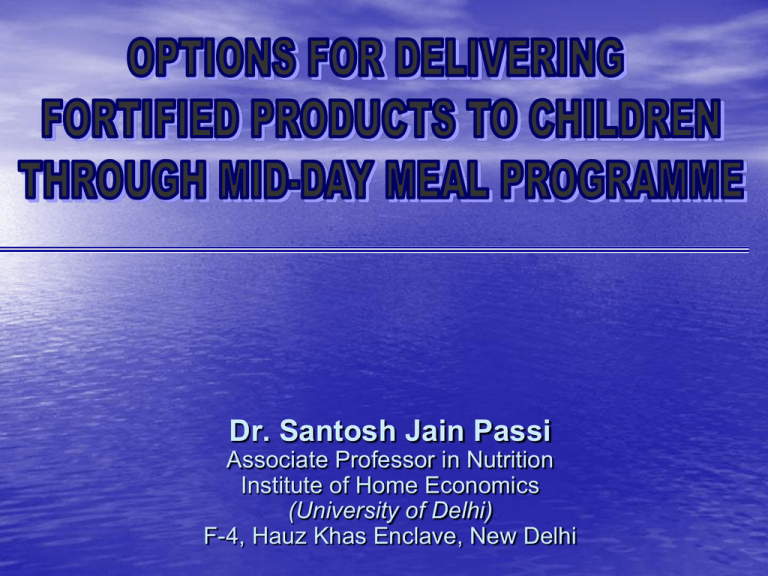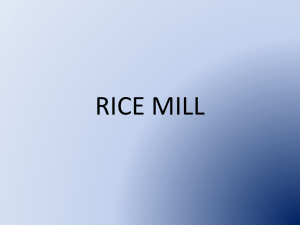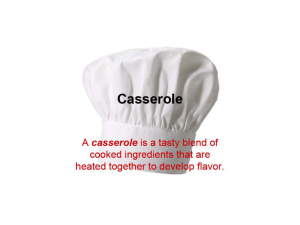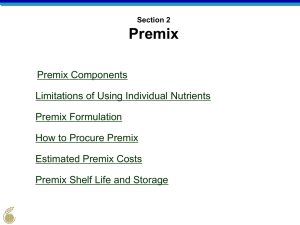Mid Day Meal Program
advertisement

Dr. Santosh Jain Passi Associate Professor in Nutrition Institute of Home Economics (University of Delhi) F-4, Hauz Khas Enclave, New Delhi “Indian children suffer not only from educational neglect but also from under nourishment on a scale that makes India a world-beater in an unenviable role; therefore, supplementary feeding programmes can be very effective in addressing several pivotal problems together”. (Amartaya Sen ,2005) “Schools could be a valuable second front in attempts to bring nutrition and health upliftments among the children.” (Gopalan, 1974) • Mid- Day Meal Programme (MDMP) Also known as National Programme of Nutritional Support to Primary Education (NP-NSPE) is one of the largest nutrition support schemes in the world. • Launched on 15th August, 1995 to boost the UEE by increasing enrollment and attendance coupled with a reduction in absenteeism; and simultaneously to improve the nutritional status of children in primary classes. • Coverage increased from 3.4 crore in 1995-96 to over 15 crore children in rural/ urban areas in 2010. • In view of the Government’s commitment to UEE, the programme has been extend to the children in Upper Primary classes (VI – VIII). Distribution of Children by Adequacy of their Energy Intake (% of RDA) 70 MCD: n = 120 NDMC: n = 120 60 Percent children 50 40 30 20 10 0 RTE phase Cooked meal Phase Non-school day Fruit phase MCD Schools <50% 50%-<60% Cooked meal Phase Non-school day NDMC Schools 60%-<75% 75%-<90% >90% Rekhi and Passi, 2007 Distribution of Children by Adequacy of their Protein and Micronutrient Intake (NAR Approach) MCD School Children (n = 120) Cooked Meal Phase (MCD schools) Non School Day (MCD School Children) 100% 90% 80% 70% 60% 50% 40% 30% 20% 10% 0% ac As co rb ic N ia c id in n fla vi R ib o in Th i am Vi e tA n Iro al c Pr C ot ei n ac or bi c sc A iu m id in ia c N fla vi n e ib o R ia m in Th V it A n Iro iu m al c C P ro te i n 100% 90% 80% 70% 60% 50% 40% 30% 20% 10% 0% NDMC School Children (n = 120) Non School Day (NDMC Schools) Cooked Meals Phase (NDMC Schools) 1.0 0.66 <1.0 Ni ac in As co rb ic ac id vin of la Ri b in e Th ia m tA Iro n <0.66 Vi Vi tA Th ia m in e Ri bo fla vin Ni As ac in co rb ic ac id Pr ot ei n <0.66 ciu m 0.66-1.0 100% 90% 80% 70% 60% 50% 40% 30% 20% 10% 0% Ca l >1.0 Iro n Pr ot ei n Ca lci um 100% 90% 80% 70% 60% 50% 40% 30% 20% 10% 0% Rekhi and Passi, 2007 Nutritive Contribution of Cooked Mid-Day Meals (per serving) Menus Energy (kcal) Protein (g) Fat (g) Calcium (mg) Iron (mg) Vitamin A RE (g) Thiami n (mg) Riboflav in (mg) Niaci n (mg) Ascorbi c acid (mg) MCD Schools 240 6.1 3.7 42.1 1.16 50.8 0.08 0.06 1.4 1.4 Rajmah Chawal 237 7.1 2.9 52.3 1.25 10.8 0.03 0.03 0.85 0.9 Vegetable Pulao 247 6.8 7.8 38.6 1.57 240.7 0.12 0.06 1.31 3.6 Daal Chawal 235 7.3 2.9 17.8 1.00 17.9 0.11 0.06 1.26 0.3 Poorie Choley 375 9.9 14.9 64.7 3.60 67.1 0.33 0.12 2.94 1.4 Poorie Aloo 360 7.6 14.1 32.4 3.02 52.9 0.33 0.10 3.04 9.3 Average nutritive contribution 282 7.5 7.7 41.31 1.93 73.37 0.17 0.07 1.8 2.81 Choley Chawal NDMC Schools Mixed Veg. Pulao 313 7.3 9.3 38.4 1.29 5.7 0.27 0.05 4.27 13.5 Channa Dal Pulao 312 9.3 10.3 37.4 1.84 7.4 0.28 0.07 3.92 3.5 Daal Chawal 235 7.3 2.9 17.8 1.00 17.9 0.11 0.06 1.26 0.3 Black Channa Pulao 288 7.2 6.5 68.2 1.73 11.8 0.18 0.06 2.36 4.05 Poori Aloo 322 6.4 13.9 36.2 2.57 23.8 0.29 0.09 2.62 13.9 Poori Choley 315 8.1 13.6 62.6 2.88 15.8 0.26 0.09 2.30 3.0 Average nutritive contribution 298 7.6 9.4 43.43 1.89 13.73 0.23 0.07 2.79 6.38 Rekhi and Passi, 2007 Options for Food Fortification – Premix/ Sachet Approach – Fortified Flour/ Ultra Rice – Ready to Eat Foods (RTEs) – Food - Food Fortification Premix/ Sachet Approach Benefits of adding the vitamin/ mineral premix – – – – Economical Require little infrastructural mechanism Quality control mechanism can be simple Nutrient losses during mixing/ food preparation can be minimised a) Addition of the Premix before Cooking • Require no special measuring skills/ literacy on the part of users. • Pre-weighed/ pre-portioned sachets can be used. • Once the premix is blended with the ready to use staple cereal like flour, it can be used as and when necessary for the preparation of MDM. – Ultra Rice premix can be blended with local rice (~1:100) to meet 1/2 to 1/3rd of the RDA of the micronutrients. Ultra Rice premix is a micronutrient-fortified product (containing vitamin A, iron, zinc, thiamine, and folic acid) made from extruded rice flour, that resembles natural milled rice grains in size, shape, color, and density; and imparts no taste or smell to uncooked / cooked rice. b) Addition of Premixes During Cooking • Premix sachets can be added to the food during cooking or nearing preparation. Vita Shakti is available in sachets containing 1.25 g of the premix (sufficient for 5 persons). One serving provides 14mg iron, 150 mcg vitamin A, 50 mcg folic acid. c) Addition of Premixes after Cooking • For instant fortification, the premix can be sprinkled on the cooked food and thoroughly mixed to ensure proper distribution. Single-dose sachets of a weighed amount containing a blend of micronutrients in a powder form can be easily sprinkled on any food. Anuka – A multiple micronutrient containing single serving sachet provides 12 mg iron, 5 mg zinc, 300 mcg vitamin A, 40 mg vitamin C, 50 mcg folic acid. Some of the Cooked MDM Menus States Cooked Foods Served in MDMP • Andhra Pradesh Rice-Sambar, Rasam, Tamarind / Tomato rice, Pongal • Delhi Mixed Veg. Pulao, Dal /Sambar Rice, Rajmah Rice, Choley Rice, Aloo-Poori, Choley-Poori, Black Channa Pulao • Gujarat Dal Dhokli, Khichidi, Veg. Pulao, Handvo, Upma • Haryana Dalia, Khichdi • Karnataka Sweet-Pongal, Rice-Sambar, Roti-Sabzi, Bisibele Bhath, Upma, Chitaraana (lemon rice) • Rajasthan Ghooghri, Dalia, Sattu, Lapsi • Tamil Nadu Tamarind rice, Sambar rice, Dadhojjanam, Pongal, Coconut rice, Halwa/ Shira Source: NPNSPE, 2005 Distribution of school children (MCD/ NDMC) by their breakfast Intake and Tiffin Carrying Practices - Before / After Introduction of Cooked Meals Breakfast and Tiffin carrying practices MCD SCHOOLS (n= 120) NDMC SCHOOLS (n=120) POOLED DATA (n =240) RTE Phase Cooked Meals Phase % change Fruit Phase Cooked Meals Phase Eat BF and carry Tiffin 72 (60.5) 22 (18.5) 42% 94 (78.3) 27 (22.5) 55.8% 49.0% Eat BF, carry no Tiffin 22 (18.5) 66 (55.5) 37% 13 (10.8) 72 (60.0) 49.2% 43.1% No BF, only carry Tiffin 13 (10.9) 9 (7.6) 3.3% 12 (10.0) 1 (0.8) 9.2 6.3 No BF, carry no Tiffin 12 (10.1) 22 (18.5) 8.4% 1 (0.8) 20 (16.7) 15.9% 12.2% BREAKFAST CONSUMPTION PRACTICES 94 (78.3) 88 (73.3) 6.4% 107 (89.2) 99 (82.5) 7.5% 6.9 % TIFFIN CARRYING PRACTICES 85 (70.8) 31 (25.8) 63.5 % 106 (88.3) 28 (23.3) 73.6 % 68.6 % % change (% change) Rekhi and Passi, 2007 Commercially Manufactured Low-Cost Fortified Ready to Eat Foods Fortified RTEs such as Biscuits, Mathris, Namakparas, Laddos and Extruded Foods can be given to the children as morning snack in addition to the hot cooked meal served later. • Iron Fortified Biscuits: Children studying in primary classes were given Iron Fortified Biscuits two each (providing 10 mg iron) per day for 84 school days. Another group of Children were given four biscuits (providing 20 mg iron) per day for 50 school days. The study indicated an improvement in their Hb status. • Sweet ready mix consists of roasted wheat flour, full fat soya flour, and sugar; and the Extruded Snack Food consists of wheat, full fat soya flour, maize, Bengal gram, spices, salt, edible oil. Both the products are fortified with vitamins and minerals. • Indiamix is a ready to eat precooked blended food containing wheat (75%), full-fat soya (25%) suitably fortified with the required micronutrients; provides about 20% protein, 6% fat and 390 Kcal/100 g. • Fortified Mamri - an extruded ready to eat snack (made of Bengal gram powder, wheat flour, oil, salt and sugar. Food- Food Fortification This can be achieved through the use of Red Palm Oil, Dehydrated GLV Powder and defatted soy flour. β-carotene Enriched Biscuits • In our DRDO funded research project, the children (classes I – III) were given six biscuits each for on-the-spot consumption for 50 school days. Expt group: was given β-carotene enriched biscuits prepared using red palm oil (provided 353 kcal, 4g protein and ~2152 mcg of β-carotene) Placebo group: was given non-enriched biscuits similar in appearance and composition except the β-carotene. Serum retinol concentration of the experimental group increased significantly (170.9%) as against a nominal increase in the placebo group (37.5%). Passi, Singh and Ranjan, 2010 Conclusion A combination of these approaches can, thus, be adopted for delivering fortified products to children through mid-day meal programme. •Morning Snacks: • Fortified ready to eat foods as a Morning snack •Hot Cooked Meals: • Micronutrient premix sachets can be added during the final stages of preparation in rice /pulao /khichri / pulse preparations and curries. • Fortified flour can be used for the preparation of poories /shira. • Red palm oil can be used in 1:1 blend with other edible oils for food preparation, particularly the bakery items to keep the TFA content at low levels. • Dehydrated green leafy vegetables powder can be added to MDM menus to further improve their micronutrient content.






